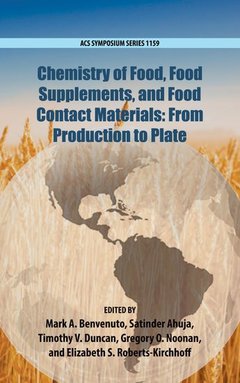Description
Chemistry of Food, Food Production, and Food Contact Materials
From Production to Plate
ACS Symposium Series
Coordinators: Benvenuto Mark A., Ahuja Satinder, Duncan Timothy V., Noonan Gregory O., Roberts-Kirchhoff Elizabeth S.
Language: English
Subjects for Chemistry of Food, Food Production, and Food Contact...:
Publication date: 03-2016
136 p. · 16.2x23.1 cm · Hardback
136 p. · 16.2x23.1 cm · Hardback
Description
/li>Biography
/li>
For more than a century, national and international governing bodies have had some involvement in regulating the quality and safety of food during production and delivery. Since the beginnings of this "modern" food regulation in the early 20th century, the way that food is produced, packaged and distributed has changed drastically. It is difficult to determine if technological advances in the areas of polymer science, refrigeration, and transportation have driven the globalization of the food supply or if the food industry has drawn from these technologies to satisfy consumer's desire and need. Ensuring the safety of food requires a complex and ever-changing set of interactions between producers, distributors, consumers and regulators. As advances are made in packaging and food additives, as food distributions systems evolve to meet consumer needs, or as these respond to environmental and population changes, adjustments to regulatory systems may become necessary. Analytical, environmental and materials chemistry can often play important roles in responding to these changes and in continuing to help with the improvement of food safety and security. These five co-editors bring their respective expertise to the subject of the food system and the chemical advancements behind it.
Mark Benvenuto is a Professor of Chemistry at the University of Detroit Mercy, in the Department of Chemistry & Biochemistry. Benvenuto received a B.S. in chemistry from the Virginia Military Institute, and after several years in the Army, a PhD. in inorganic chemistry from the University of Virginia. After a post-doctoral fellowship at the Pennsylvania State University, he joined the faculty at the University of Detroit Mercy in 1993. Satinder Ahuja worked at Novartis Corporation for over 25 years in various leadership positions and simultaneously served as adjunct professor for several universities. For the last decade, he has been helping solve water contamination problems worldwide. As a founder of Ahuja Academy of water Quality at UNC Wilmington, he encourages research on various water quality issues. Timothy Duncan is a research scientist at the Center for Food Safety and Applied Nutrition, part of the U.S. Food and Drug Administration. His primary research focus is safety of nanomaterials utilized in foods and food contact materials. Dr. Duncan received his B.S. in chemistry from Haverford College and his Ph.D. in physical/inorganic chemistry from the University of Pennsylvania, where he also completed a post-doctoral fellowship. He has been with FDA since 2009. Gregory Noonan is a Research Chemist in the Office of Regulatory Science in the Center of Food Safety and Applied Nutrition at the US Food and Drug Administration. Noonan received his B.S. in chemistry from SUNY Albany and his M.S and Ph.D. in chemistry from Michigan State University. He also worked as a postdoctoral fellow in the Department of Civil Environmental Engineering at the Massachusetts Institute of Technology. Elizabeth S. Roberts-Kirchhoff is Professor of Chemistry and Biochemistry at the University of Detroit Mercy. Roberts-Kirchhoff received a B.S. in Chemistry from Texas A & M University and a Ph.D. in Biological Chemistry from the University of Michigan. After postdoctoral research at
© 2024 LAVOISIER S.A.S.
These books may interest you

Food Additives and Packaging 195.39 €



